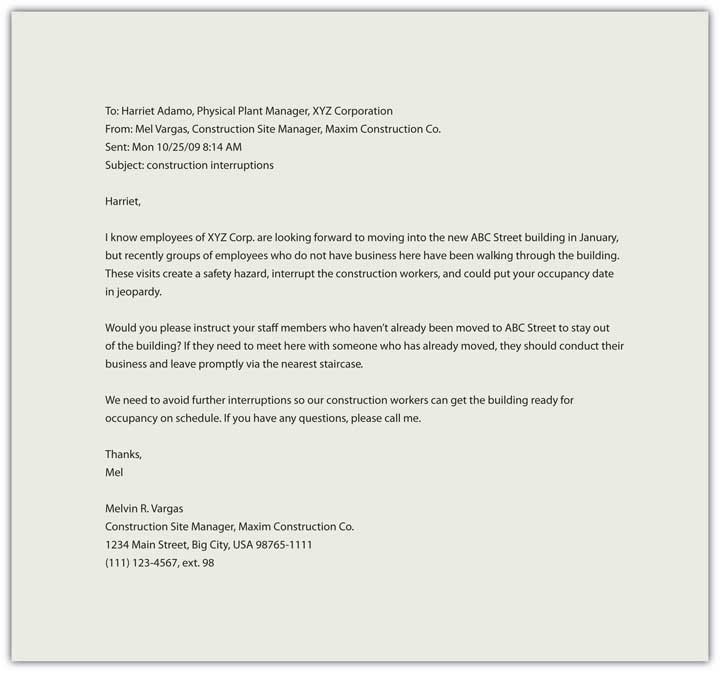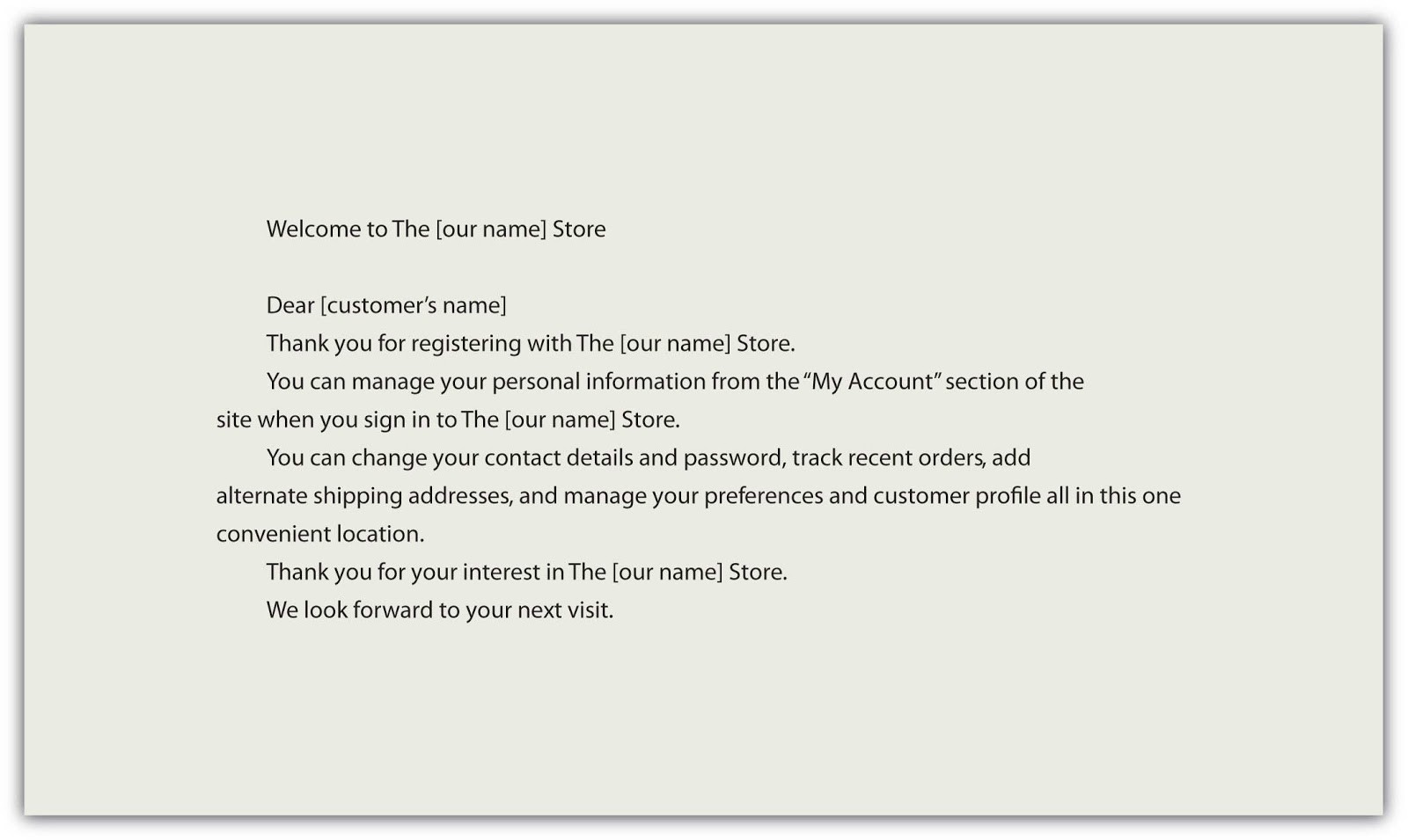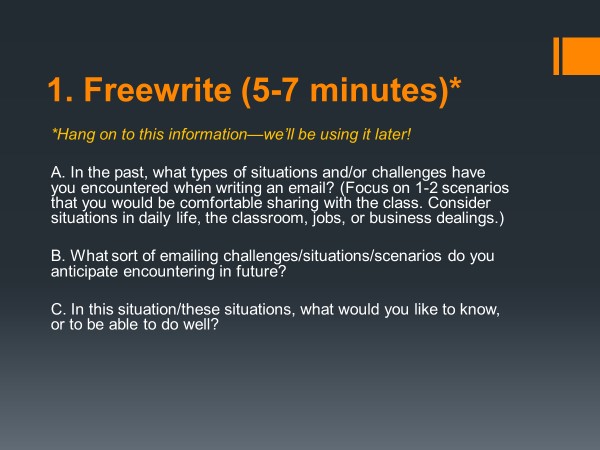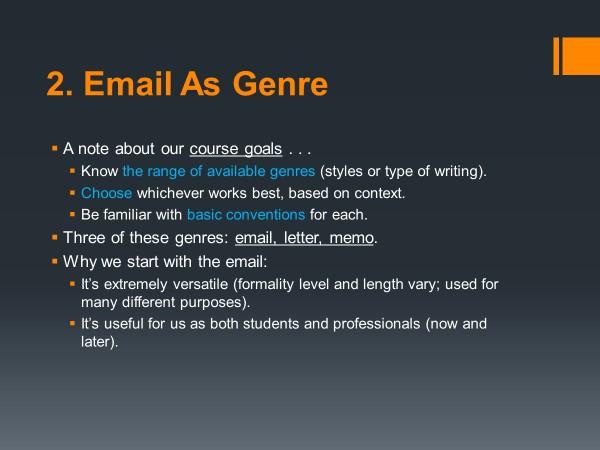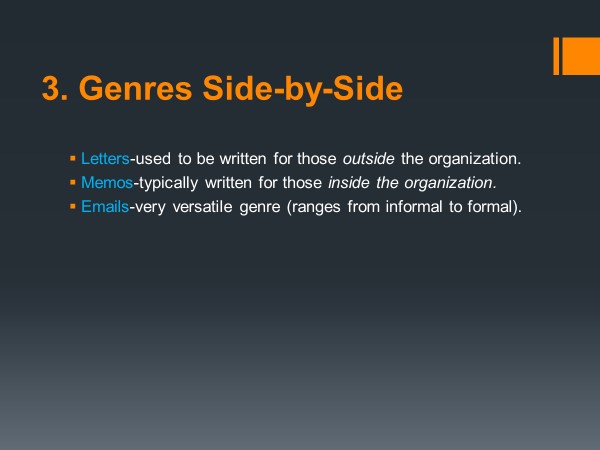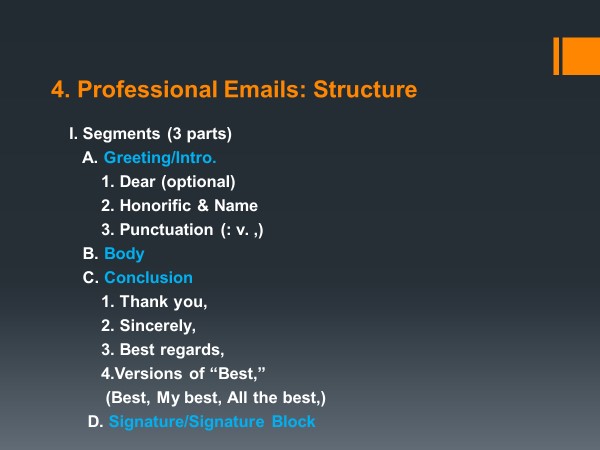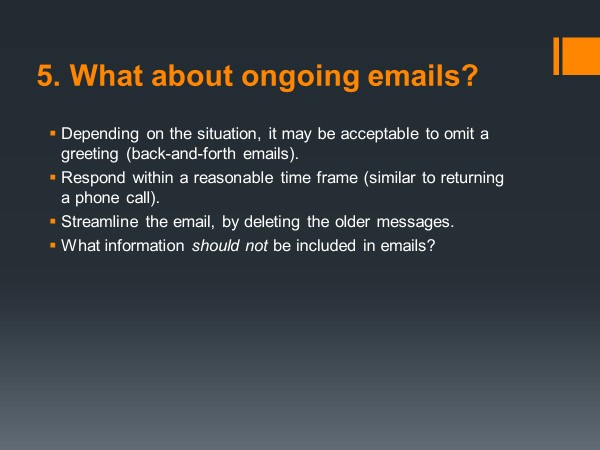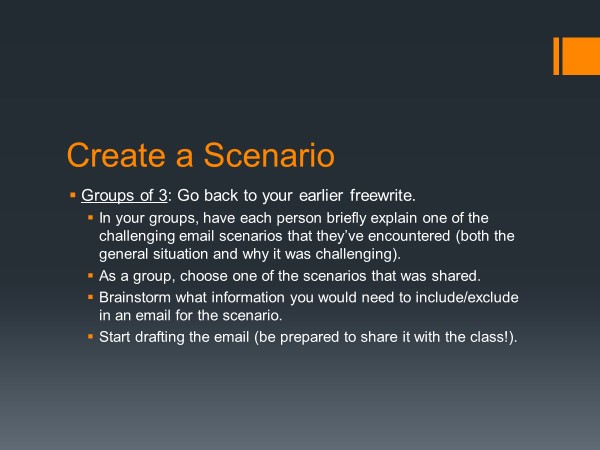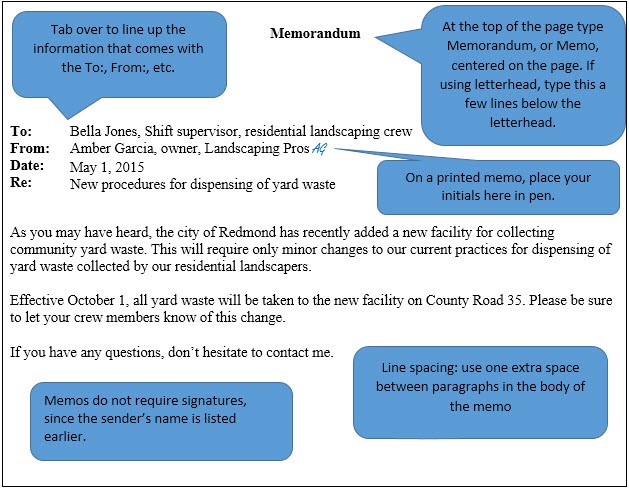Chapter 6: Emails, Memos, and Texting
Katrina Peterson
Chapter Synopsis
This chapter introduces the basics of email writing and etiquette, also providing information on memos and texting. It offers suggestions about when (and when not to!) use email in business communication. It details the basic conventions of structure: the header/address information, greeting, message body, and closing. It gives an overview of Netiquette, the expectations of online etiquette, which has application for other genres of online communication as well. The chapter concludes with a bulleted list of takeaways and tips, followed by additional teaching and learning resources.
6.1 Email Introduction
Electronic mail, or email, is among the most versatile genres of business writing. It is used to communicate issues ranging from serious to trivial, and its formality level varies greatly based on context and rhetorical situation. It may be used like text, or synchronous chat, and recipients often choose to access email messages on a cell phone. When composing an email, a sender must account for the time constraints readers may face due to high email volume. Recipients, on the other hand, should plan to answer a business email within 24 hours, or the general time frame that they would respond to a text. Strong subject lines, clear formatting, and concise writing are all characteristics of a well-written email. Emails may also present ethical challenges as the forwarding and carbon copy functions enable communications to be shared with additional recipients.
Email, texting, and microblogs are all workplace tools that are used both internally and externally. Prior to email, genres of business writing were more clearly differentiated based on function: hard copy letters were sent outside the company, and memos were directed to those inside the company. This distinction still exists in some business contexts, but email has largely replaced hard copy letters in external and internal correspondence. Email can be very useful for messages that have more content than a text message, but conciseness remains one of its major features. A clear structure with a greeting, message body, and closing is also expected of this genre.
Many businesses use automated emails to acknowledge communications from the public, or to remind associates that periodic reports or payments are due. The form email is also common; in this case, a recipient chooses from a menu of sentences to make the wording suitable for a specific transaction. Email may be informal in personal contexts, but business communication requires attention to detail, awareness that an email reflects both you and your company, and a professional tone. Although email may have an informal feel, remember that it needs to convey professionalism and respect. Never write or send anything that you would not want to share publicly, or in front of your company president.
6.2 When (and When Not!) to Email
Email is a good way to communicate when:
- You need to contact a person who is difficult to reach via telephone, does not come to campus regularly, or is located in another part of the country or world (for instance, someone who lives in a different time zone).
- The information you want to share is not time-sensitive. Email is instantaneous, but it does not guarantee an instantaneous response. For many people, keeping up with their email correspondence is a part of their job, and they only do it during regular business hours. Unless readers have promised otherwise, assume that it may take a few days for them to respond.
- You need to send someone an electronic file, such as a document for a course, a spreadsheet full of data, or a rough draft of your paper.
- You need to distribute information quickly to many people (for example, a memo that needs to be sent to the entire office staff).
- You need a record of the communication. Saving important emails can be helpful if you need to recall what someone said in an earlier message, provide proof (for example, as receipt for a service or product), or review the content of an important meeting or deadline.
- You are unable to ask a direct question or make a request in person. In this case, frame your question/request politely, being careful to avoid a demanding tone or the underlying assumption that your request will be granted.
Email is not an effective means of communication when:
- Your message is long (i.e. could not be read in 20 minutes or less), complicated, or requires additional face-to-face discussion. For example, if you want feedback from your supervisor, or if you are asking your professor a question that requires more than a yes/no answer, you should schedule a meeting instead.
- Information is highly confidential. Email is NEVER private! Keep in mind that your message could be forwarded to other people without your knowledge. A backup copy of your email is always stored on a server where it can be retrieved, even when you have deleted the message and think it is gone forever.
- The tone of the message could be misconstrued. If you would hesitate to say something to someone’s face, do not write it in an email.
- The information itself is emotionally charged. For example, if you must communicate bad news to someone, it is better to deliver it in person.
6.3 Email Structure
Professional communication requires careful attention to the specific writing context. In addition to its language and content, the structure of a email should also reflect a writer’s understanding of audience and purpose; a well-crafted email helps to establish credibility with an audience by showing awareness of the genre’s conventions, or its standard moves and expectations. The principles explained here apply to the educational context as well as business writing, so be sure to use them when communicating with your instructors and classroom peers. Four elements of structure should be considered when composing an email: the header/address information, greeting, message body, and closing.
Header/Address Information
As used here, header/address information refers to the subject line and the recipient lines: To, Cc, and Bcc. Make sure you include a clear, brief, and specific subject line. This helps recipients to quickly grasp the essence of a message. Email subject lines are like newspaper headlines. They should convey the main point of your email or the idea that you want readers to take away from it. They may also keep the email from being diverted to a junk mail folder, so be as specific as possible. One-word subjects such as Hi, Question, or FYI are not informative and may undercut the message’s importance. Overly long or rambling subjects may result in a similar problem. Instead, consider using a subject line like Economics Proposal Attached or Your English 110 Question. If the message is time sensitive, it may be helpful to include a date: Meeting on Thurs, Dec 2. Also keep in mind: just as an email’s subject line can communicate either professionalism or a lack of it, so also does your own email address. Consider two brief examples: jackjohnson@yahoo.com and bigdaddy2000@gmail.com. The former address is clearly more professional, including the sender’s name for easy recall. In contrast, the latter lacks professionalism, coming across as overly casual and informal.
The email’s recipient lines should be given careful thought as well. In general, copying individuals on an email is a good way to deliver your message simultaneously to several people. In professional settings, copying someone else on an email can help get things done, especially if the person receiving the copy is in a supervisory role. For example, copying your boss on an email to a nonresponsive co-worker might prompt the co-worker to respond. Be aware, however, that when you send a message to more than one address using the Cc: (or carbon copy) field, both the original recipient and all the recipients of the carbon copy can see all the email addresses in the To: and Cc: fields. Each person receiving the message will be able to see the addresses of everyone else. Also, while carbon copying supervisors on an email may prompt immediate action from the original recipient, this option may raise important ethical and/or rhetorical considerations. If injudiciously used, it may have the appearance of manipulating recipient(s).
Blind carbon copying (Bcc-ing) emails to a group of people can be useful when you do not want everyone on the list to see each other’s email addresses. The only address that will be visible to all recipients is the one in the To: field. If you prefer not to show any of the listed email addresses, you can put your own address in the To: field and use Bcc: for recipients’ addresses.
Based on previous discussion, you may be wondering, “In what situations would the Cc: and Bcc: functions be helpful and appropriate to use?” As a student and a professional you will work collaboratively at some point—for example, on a class project—and need to ask a question of a supervisor or professor, perhaps at the request of group members. You would of course have the option to email the inquiry directly, later sending the response you receive to your group. However, you might also choose to include classmates in the Cc: line of the original email: 1) to keep them in the loop and confirm that you have followed through on their request, 2) to provide the professor with the option of hitting Reply All in order to inform the group directly, and 3) to preclude the need for a separate email if/when the professor responds to the group as a whole. If you do include others in the Cc:, however, you will may want to draw attention to that fact in your email, so that the respondent does not overlook the carbon copied individuals due to high email volume.
The previous information gives a sense of just how useful carbon copying can be—it may offer a means of cutting out an extra step in the communication process, while keeping others informed. However, the Bcc: may be trickier to determine when to use, due to the blind aspect of its communication. As noted, it may be a good option if you wish to deliver information to additional recipients while obscuring their email addresses. Perhaps you did not obtain permission to share their email information with others, but you had offered to send them the information as well. In such an instance, the Bcc: will enable you to be respectful of their privacy, while avoiding sending a separate email.
In other instances, you may be called upon to make a more difficult decision, for example, when working with a challenging co-worker. Perhaps this co-worker has a history of unwise decision-making, like violating company policy or not following through on required procedures. If your supervisors are aware of the situation, they may ask that you keep them updated on developments as a form of documentation. As part of your job, you might have to remind the individual of a company procedure that has not been followed. Your supervisor may want to know that the individual has been informed of the policy, and you may simultaneously wish to avoid fallout with a co-worker who could misunderstand the supervisors’ request for information. Including your supervisors in the Bcc: would be one way to make them aware of the steps you have taken to address a situation or fulfill the duties of your job position.
When drafting a message with sensitive content, you might consider waiting to enter recipients’ email addresses to ensure that the email is not sent until after you have edited the document; after all, send is only one click away. The same holds true for the Cc: and Bcc: lines, which raises another important consideration. The instantaneous aspect of email communication can be both blessing and curse. No writer wants to send an email inadvertently, and yet many senders make the mistake of emailing a quick reply when strong emotions have the upper hand. Especially when an individual is on the receiving end of an angry email, anger may seem like the appropriate response. However, such a step is unprofessional and may have serious ramifications. Avoid flame wars. When tempted to send an emotional response, always wait; instead, consider holding off until the message can be phrased in a more objective, professional manner.
Greeting
When first initiating contact by email, open with an appropriate greeting or salutation. Avoid simply starting with the message body and be sure to include a polite signature. Proper greetings and closings demonstrate respect, also helping to avoid mix-ups in case a message is sent to the wrong recipient. For example, you might consider using a greeting like Dear Ms. X (formal, for someone external to the company) or Hi Barry (informal, for someone you know well). Unless someone has expressed an individual preference, never use the title Mrs. as you cannot assume a woman is married.
If the gender of a person is not evident, use the entire name, like this: Dear Sam Jones. If you do not know the person well, it may be confusing to identify an appropriate greeting (What do I call my TA/professor?) or closing (From? Sincerely?). When in doubt, address recipients more formally to avoid offending them. Some common ways to address readers are: Dear Professor Smith, Hello Ms. McMahon, or Hi Mary Jane. If a person’s name is not available, or if the email addresses a diverse group, try something both generic and polite: To whom it may concern, Dear members of the selection committee, or Hello everyone.
Message Body
When writing an email, here are some tips to ensure that the message is clear and accessible. In general, avoid using all caps since it may have the appearance of yelling. Emojis, though helpful in informal communications like texting with friends, may also be perceived as unprofessional in business contexts. Use bolding, underlining, and italics as needed to increase clarity, but be careful not to overload readers with too much at once. Bullet points may be helpful for sharing listed information, while included links may permit recipients to access information quickly. Double-check these links before sending, however, to ensure that they work.
State your purpose for writing directly at the email’s beginning to provide a context for your message. Reference any included attachments up front as well, so that readers are aware of the additional content and its purpose; in your email state the name of the file, along with the type of document and program needed to open it, for example: “Please see the attached Word document of my essay, The Many Facets of Richard III.” In the case of an included question, cut and paste any relevant text (for example, computer error messages, assignment prompts, segments of a previous message, etc.) into the email so that the reader has a frame of reference from which to answer. When replying to someone else’s email, it may be helpful to either include or restate the sender’s message. Conversely, if you are emailing back and forth with the same person, you might delete the previous messages to avoid clutter and make communication more direct.
Use paragraphs to separate thoughts (or consider writing separate emails if you have many unrelated points or questions), and state the desired outcome at the end of your message. When requesting a response, let the reader know what type of response you require (for example, an email reply, possible meeting times, a recommendation letter, etc.). If you request something that has a due date, be sure to place the due date in a prominent position in your email. Ending your email with the next step may be helpful in work settings (for example, you might write “I will follow this email up with a phone call this week” or “Let’s discuss this further at the Wednesday meeting”).
Closing
An email’s closing is extremely important because it identifies the sender and provides contact information. Always include your full name at the end of your email. In an educational context, keep in mind that your professor may be teaching multiple students with the same name, or multiple sections of many students, so including your class/section number along with first and last name is a good idea. When closing, end with something brief but friendly: Thank you, Best wishes, See you tomorrow, or Regards. For a very formal message, such as a job application, use the kind of closing that you might see in a business letter: Sincerely, or Respectfully yours. If you do not know the reader well, you might also consider including your title and the organization you belong to, for example:
Mary Watkins
Senior Research Associate
or
Bain and Company
or
Joseph Smith
UNC-CH, Class of 2009
6.4 Netiquette
Netiquette refers to etiquette on the net, or protocols and norms for online communication. These general guidelines apply to most forms of electronic communication, including email. We may send or post messages, create personal pages, and interact via online technologies as a normal part of our careers, but how we conduct ourselves will leave a lasting image. The photograph you posted on your Facebook page or Twitter feed may be seen by a potential employer, or a nasty remark in a post may come back to haunt you later. Since the days when the Internet was a new phenomenon, Virginia Shea and others have sought to establish ground rules like the following for online contexts:
- Remember the human on the other side.
- Make an effort to forgive mistakes.
- Avoid assumptions about your readers.
- Ask for clarification and delay judgment.
- Consider possible cultural differences.
- Check your tone before you publish.
- Think of the text as permanent.
- Be aware that jokes and sarcasm may be misunderstood.
- Establish ground rules when working collaboratively.
- Respect original ideas by quoting correctly and asking permission.
- Research your organization’s Acceptable Use Policy.
- Respect people’s privacy.
- Do not abuse your power.
- Keep flame wars under control.
- Know where you are in cyberspace.
- Respect others’ time and bandwidth.
- Create a positive online image.
- Share expert knowledge.
Basically, you should adhere to the same polite standards of behavior online that you follow in real life. Such rules remind us that the golden rule (treat others as you would like to be treated) is relevant in any human interaction. Because basic social conventions for writing and responding to email are continually in flux, miscommunication can easily occur when people have different expectations about the communications that they send and receive.
6.5 Takeaways and Tips
- Electronic mail, or email, is among the most versatile genres of business writing.
- Email has largely replaced hard copy letters in external and internal correspondence.
- Context and the conventions of genre help to determine when/when not to use email.
- A clear structure (header/address information, greeting, body, and closing) is expected.
- Netiquette matters—remember the golden rule in all communications.
- Always proofread for tone, spelling, grammar, and content before hitting send.
- When possible, respond to an email within 24 hours, but account for possible delays in response from others.
- Be aware of the uses and ethics associated with Reply All and Carbon Copy functions.
- Avoid using all caps; use formatting like underlining and bolding to make reading easier.
- Test links before sending, to ensure they work properly.
- Follow up politely when necessary to ensure that the information was received.
- Always remember that electronic communications are not private.
6.6 Sample Emails for Discussion
6.7 Sample Activities
Use what you have just learned to explain why Student 2’s email to Professor Jones is more effective than the email written by Student 1. How does the tone of the messages differ? What makes Student 2’s email look and sound more appropriate? What are the elements that contribute its clarity? If you were Professor Jones and you received both emails, how would you respond to each one?
Email from Student 1:
hey,
i need help on my paper can i come by your office tomorrow
thx
Email from Student 2:
Hi Dr. Jones
I am in your ENGL 101 class on Thursdays, and I have a question about the paper that is due next Tuesday. I’m not sure that I understand what is meant by the following sentence in the prompt: “Write a 10 page paper arguing for or against requiring ENGL 101 for all UNC freshmen and provide adequate support for your point of view.” I am not sure what you would consider adequate support. Would using 3 sources be o.k.? Can I come by your office tomorrow at 2:00 pm to talk to you about my questions? Please let me know if that fits your schedule. If not, I could also come by on Friday after 1:00.
Thank you,
Tim Smith
Here are two versions of an email from a supervisor, Jane Doe, to a group of her employees. Which version do you think is most effective? Why?
Version 1 of Jane Doe’s Email:
As you know, tomorrow afternoon we’ll be meeting to discuss the status of all of our current projects. Donuts will be provided. Be sure to arrive on time and bring along the materials you have been working on this week—bring enough copies for everyone. Some of these material might include your calendars, reports, and any important emails you have sent. Also, I wanted to remind you that your parking permit requests are due later this week; you should turn those in to Ms. Jones, and if she is not at her desk when you stop by, you can email them to her.
Version 2 of Jane Doe’s Email:
Subject: Materials for Wed. Staff Meeting
Hi, everyone—
For tomorrow’s 3 p.m. staff meeting in the conference room, please bring 15 copies of the following materials:
· Your project calendar
· A one-page report describing your progress so far
· A list of goals for the next month
· Copies of any progress report messages you have sent to clients this past month
Jane
6.8 Sample Slides
6.9 Memo Introduction
A memo—or memorandum, meaning reminder—is used for communicating policies, procedures, or related official business. It is less versatile than the typical email in audience and formality level; its recipients usually consist of individuals within rather than outside of an organization, and it rarely adopts an informal tone. It tends to be written from a one-to-all perspective (like mass communication), broadcasting a message to multiple recipients, rather than a single individual. A memo must be concise, well organized (following the guidelines given in the next section), and addressed to specific audiences with standard subject lines.
Memos are a place for just the facts, and should have an objective tone without personal bias, preference, or interest on display. The successful operation of a company may depend on memos—possibly even memos that are sent via email—for communication between the employees of the company. Types of memos include: inquiries, recommendations, problem-solution, etc. The memo’s message is direct and follows a preset format for easy access to information. While it may contain a request for feedback, the memo is linear, from the organization to the employees, or from one employee to another. It may be used to update a team on activities for a given project, or to inform a specific group within a company of an event, action, or observance. The memo as a genre may have legal standing, as it often reflects policies or procedures; it may reference an existing or new policy in the employee manual, for example.
All organizations have both informal and formal communication networks. One effective way to address informal, unofficial speculation involves sending a memo that clearly states what the status of a specific issue. If budget cuts are a concern, then it may be wise to send a memo explaining imminent changes. A memo’s primary purpose is informational in nature, but it occasionally includes an element of persuasion or a call to action. This call to action does not often require personal spending, but it does represent the organization’s interests. Memos may also include statements that align business and employee interest, thereby underscoring common ground and benefit. For example, on February 13, 2009, upper management at the Panasonic Corporation issued a declaration that all employees should buy at least $1,600 worth of Panasonic products. The company president noted that if everyone supported the company with purchases, it would benefit all.
Memo Format
A memo includes a header or heading block, an introduction, a body, and a conclusion. The header identifies the recipient (To:), the sender (From:), the date (Date:), and the subject of the message (Re: or Subject:). Similarly to the email, the memo’s subject is declared in the subject line and should be clear and concise (Oregon 20). If the memo announces the observance of a holiday, for example, the holiday should be named in the subject line—for example, use Thanksgiving Weekend Schedule rather than Holiday Observance. Again, as with the email, pay particular attention to the title of the individual(s) in this section to ensure accuracy and communicate respect.
The order of the parts of the memo heading block and location of specific part of the block varies, according to different companies’ expectations. However, the message body itself has three parts, as noted. The introduction references background information and informs the purpose of the message. The body, consisting of one simple paragraph or multiple paragraphs, communicates the message. The conclusion expresses the action expected of the recipient. The conclusion could consist of one paragraph or several, or it could be simple sentence that asks for the recipient to contact the sender if there are questions.
Sample Memo
The following memo illustrates the format explained above.
6.10 Business Texting
Whatever digital device you use, written communication in the form of brief messages, or texts, is becoming a common way to connect in the business world. It is useful for short exchanges, when talking on the phone would be cumbersome. Texting is not useful for long or complicated messages, and careful consideration should be given to the audience. It can be a great tool for connecting while on the go, but consider your company, and choose words, terms, or abbreviations that will deliver your message clearly. Here are some useful tips for texting within a business context:
- Know your recipient: “? % dsct” may be a clear way to ask a close associate what discount to offer a certain customer, but if you are writing a text to your boss, it might be wiser to write, “What % discount does Murray get on $1K order?”
- Anticipate unintentional misinterpretation. Texting often uses symbols and codes to represent thoughts, ideas, and emotions. Given the complexity of communication, and the useful but limited tool of texting, keep in mind its limitations. Also be wary of using text speak like lol and fyi that might be considered overly informal.
- Be aware that contacting someone too frequently can border on harassment. Texting is a tool. Use it when appropriate.
- Unplug yourself occasionally. Do you feel lost or out of it if you do not have your cell phone and cannot connect to people, even for fifteen minutes? Sometimes being unavailable for a time can be healthy—everything in moderation, including texting.
- Never text and drive. Research shows that the likelihood of an accident increases dramatically if the driver is texting behind the wheel. Being in an accident while conducting company business would not only endanger your own health; it would reflect poorly on your employer and on your own judgment.
Attribution
Material in this chapter was adapted from the works listed below. The material was edited for tone, content, and localization.
Technical Writing, by Allison Gross, Annamarie Hamlin, Billy Merck, Chris Rubio, Jodi Naas, Megan Savage and Michele DiSilva, licensed CC-BY-NC-SA.
ENGL 145 Technical and Report Writing, by the Bay College Online Learning Department, licensed CC-BY.

